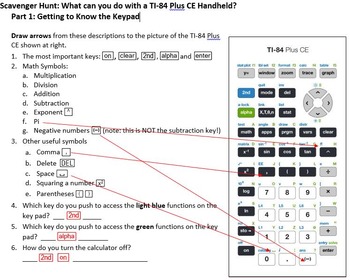Getting to Know your TI-84 Plus CE Calculator - over 1,200 copies sold!
What educators are saying
Description
A great first-day activity with TI-84 Plus CE handheld calculators! It can also be used with older model TI-83's and TI-84's and the new-for-2022 Online TI-84 for Mac, PC and Chromebook! (https://84plusce.ti.com/8eu/). Part 1: Getting to Know the Keypad scavenger hunt. Part 2: Performing Calculations, with 12 examples for student to work out; each example illustrates a different skill or set of calculation keystrokes, including cube roots and mixed numbers. If you've used my Getting to Know your TI-Nspire, the calculation problems are the same, so you can use both activities if you have a class with mixed types of TI handhelds! Part 3: Graphing Equations Step-by-Step, shows students how to graph two equations and find the intersection point, then lets them explore graphing. Students answer six questions based on their exploration. Part 4: Graphing Data and Calculating Statistics give a completed example of entering two lists of data, then creating a box plot, histogram and scatter plot from the data. An answer key is provided at the end of this .pdf document.




